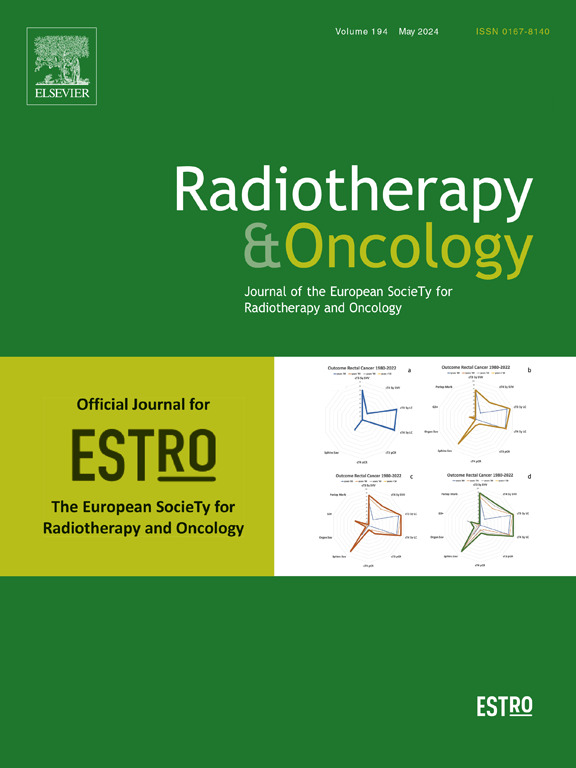立体定向消融放疗后原位肺癌复发的再照射:系统回顾和荟萃分析
IF 4.9
1区 医学
Q1 ONCOLOGY
引用次数: 0
摘要
目的胸部立体定向消融放疗(SABR)两疗程的现场再照射资料缺乏。本荟萃分析评估了在明确的SABR后,重复SABR作为现场失败抢救治疗的安全性和有效性。材料与方法按照PRISMA指南系统检索PubMed、Cochrane Library、MEDLINE和EMBASE数据库。如果研究涉及在先前的SABR后接受补救性SABR治疗的肺癌野内复发的成年患者,则纳入研究。为了解决局部失败的不同定义,纳入了在原始规划目标体积(PTV)内复发的研究。排除了场外失败(距离PTV 1 cm)或使用非sabr技术的研究。采用随机效应模型计算1年和2年局部对照(LC)率、总生存期(OS)和毒性。采用人口加权线性回归来评估剂量学和临床病理变量与患者预后之间的关系。结果纳入12项研究,共197例患者。所有患者均接受2个疗程的SABR治疗,中位总剂量为50戈瑞,分为5个部分。合并1年和2年LC率分别为78.2% (95% CI: 66 - 87%)和68.0% (95% CI: 55 - 79%)。累计生物有效剂量(BED)≥200 Gy的患者LC率显著高于(84.9%,95% CI: 70 - 93%) (64.9%, 95% CI: 54 - 75%, p = 0.02)。中位OS在低BED组和高BED组之间没有显著差异,尽管高BED有改善生存的趋势(21.4个月对32.6个月)。所有研究的中位总生存期为26.3个月(95% CI: 25.4-27.1)。LC率的提高与较小的肿瘤(2cm)、初始治疗后较高的BED以及初始和重复SABR之间较长的间隔(12个月)相关。0.01)。毒性很小,≥2级肺炎的总发生率为6.4%,只有0.10%报告≥3级毒性。结论SABR现场再照射的局部控制性较好,毒性较低,特别是对于累积BED较高(≥200 Gy)且治疗间隔较长(≥12个月)的患者。这些结果表明,对于选定的患者,重复SABR是一种可行的挽救选择。需要进一步的前瞻性研究来优化剂量和患者选择,以实现安全有效的再照射。本文章由计算机程序翻译,如有差异,请以英文原文为准。
Stereotactic reirradiation for in-field lung cancer recurrence after stereotactic ablative radiotherapy: A systematic review and meta-analysis
Purpose
There is paucity of data for thoracic in-field reirradiation with two courses of stereotactic ablative radiotherapy (SABR). This meta-analysis evaluates the safety and efficacy of repeat SABR as salvage therapy for in-field failures after definitive SABR.
Materials and Methods
A systematic search of PubMed, Cochrane Library, MEDLINE, and EMBASE databases was conducted in accordance with PRISMA guidelines. Studies were included if they involved adult patients treated with salvage SABR for in-field recurrences of lung cancer following prior SABR. To address varying definitions of local failure, studies were included if recurrence occurred within the original planning target volume (PTV). Studies with out-of-field failures (>1 cm from PTV) or those using non-SABR techniques were excluded. Pooled 1- and 2-year local control (LC) rates, overall survival (OS), and toxicities were calculated using a random-effects model. Population-weighted linear regression was employed to assess the relationship between dosimetric and clinico-pathologic variables and patient outcomes.
Results
Twelve studies involving 197 patients were included in the quantitative analysis. All patients received two courses of SABR, with a median total dose of 50 Gy in 5 fractions. Pooled 1- and 2-year LC rates were 78.2 % (95 % CI: 66–87 %) and 68.0 % (95 % CI: 55–79 %), respectively. Patients receiving a cumulative biologically effective dose (BED) ≥ 200 Gy had significantly higher LC rates (84.9 %, 95 % CI: 70–93 %) vs (64.9 %, 95 % CI: 54–75 %, p = 0.02). Median OS did not significantly differ between low and high BED groups, though there was a trend toward improved survival with higher BED (21.4 vs 32.6 months). The pooled median OS across all studies was 26.3 months (95 % CI: 25.4–27.1). Improved LC rates were associated with smaller tumours (<2 cm), higher BED from the initial treatment and longer interval (>12 months) between initial and repeat SABR (p < 0.01). Toxicities were minimal, with a pooled incidence of ≥ grade 2 pneumonitis at 6.4 % and only 0.10 % reporting ≥ grade 3 toxicity.
Conclusions
Salvage in-field reirradiation with SABR achieves high local control and low toxicity, particularly in patients receiving higher cumulative BED (≥200 Gy) and with longer intervals (≥12 months) between treatments. These results suggest that repeat SABR is a viable salvage option for selected patients. Further prospective studies are needed to optimise dosing and patient selection for safe and effective reirradiation.
求助全文
通过发布文献求助,成功后即可免费获取论文全文。
去求助
来源期刊

Radiotherapy and Oncology
医学-核医学
CiteScore
10.30
自引率
10.50%
发文量
2445
审稿时长
45 days
期刊介绍:
Radiotherapy and Oncology publishes papers describing original research as well as review articles. It covers areas of interest relating to radiation oncology. This includes: clinical radiotherapy, combined modality treatment, translational studies, epidemiological outcomes, imaging, dosimetry, and radiation therapy planning, experimental work in radiobiology, chemobiology, hyperthermia and tumour biology, as well as data science in radiation oncology and physics aspects relevant to oncology.Papers on more general aspects of interest to the radiation oncologist including chemotherapy, surgery and immunology are also published.
 求助内容:
求助内容: 应助结果提醒方式:
应助结果提醒方式:


